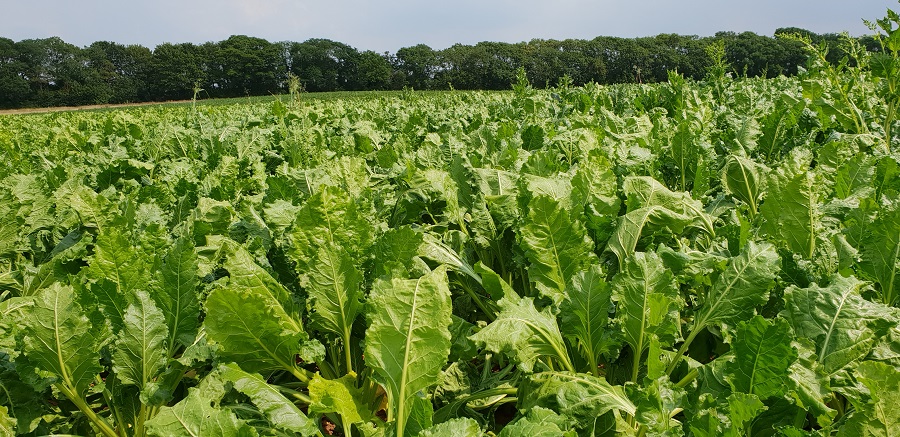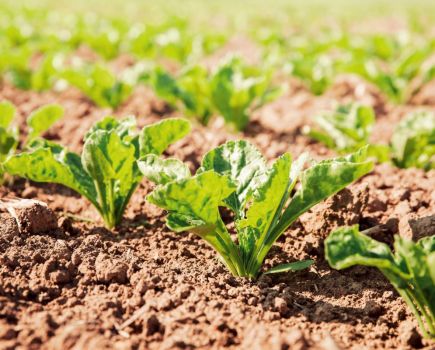The new BBRO/BSPB Recommended List has something for everyone but the star of the show may have it all in one package. CPM looks at what’s on offer.
BTS 1915 is something quite special.
By Lucy de la Pasture
Sugar beet is a crop with one of the highest variety turnovers, if their passage through the BBRO/BSPB Recommended List (RL) is anything to go by. The longest serving variety, Sabatina KWS, was added in 2015 and 14 of the 22 listed varieties are newcomers in just the past two years. It’s credited as a reflection of the tremendous progress being made by sugar beet breeders.
The new RL, announced earlier this year in March, boasts seven new sugar beet varieties for the 2021 season and includes those with traits for BCN tolerance and ALS-herbicide tolerance. One of its new entrants stands out because it moves yield potential up a bar and manages to combine this with a pretty robust-looking disease-resistance package.
Five of the seven new varieties come from the KWS stable, but the breeder has recently decided not to offer two of them to growers, explains Ben Bishop, UK country manager for sugar beet.
“We are pleased Eldorana KWS and Catriona KWS were added to the RL as the bolting performance of each is very good in both the normal and early drilling windows. But following feedback on these varieties after publication of the RL, it’s clear that growers are looking for an all-round agronomic package that will be best delivered by other varieties.”
The move from KWS reflects a more holistic approach to managing the sugar beet crop where, for a very long time, varieties have been considered primarily for their yield and sugar content. Bolting and disease resistance have now become equally important factors when it comes to selecting the right varieties to grow on the farm, reflects Ben.
The remaining three KWS varieties offer something for everyone, he says. Evalotta KWS becomes the second highest yielding variety on the RL with of an adjusted yield 103% over the control varieties. In this new world of rapid breeding progress, Ben is quite content with second place in the yield ratings.
“As the control group of varieties changes, the yield bar is being set ever higher and it’s now quite an achievement to bring forward a variety with an improved yield potential which exceeds that of Daphna – the highest yielding variety on the 2020 RL,” he says.
Putting this into context, the control varieties achieved a mean yield of 118 adjusted t/ha last season, which was up from 112t/ha in the previous one, explains Mike May, chairman of the RL Board.
Another benchmark for UK breeders is the number of bolters recorded in early and normal drilling spots. Mike says the 2021 RL highlights just how successful breeders have been at reducing bolting, with 10 out of the 22 varieties recording zero bolters in the 20 RL yield trials sown from mid-March onwards (the ‘normal’ drilling slot).
Evalotta KWS has very low bolting in the normal drilling window (after mid-March) but isn’t suitable for earlier drilling, points out Ben. For growers looking to get the crop planted in early spring, Sancha KWS provides more flexibility on drilling date, with one of the lowest number of bolters recorded when sown before 5 March in RL trials, he says.
“Sancha KWS offers a solid disease resistance package and a good sugar content which makes it a good all-round option for 2021.”
2020 has been a difficult year for beet establishment; some crops were slow to emerge into dry conditions with big fluctuations in day and night-time temperatures. Having good genetics on side may not compensate for soil conditions but gives the crop a better chance. Ben points out that both Evalotta KWS and Sancha KWS established well in the RL trials, with 102.5% and 100.6% above the controls when plant populations were assessed pre-gapping.
The final KWS newcomer is another Conviso Smart variety and will provide growers with a further choice in the ALS-herbicide tolerant portfolio, where it will join Smart Janninka KWS. Smart Rivetta KWS offers a useful yield increase over its stablemate, demonstrating the advances the breeder has made in overcoming the yield lag that’s so often seen when a new trait is introduced.
“Smart Rivetta KWS is listed as performing at 92.5 % of the yield of control varieties (compared with Kanninka KWS at 88.7%). But it’s important to consider that the RL trials use a classical herbicide programme on the ALS-tolerant varieties, so the yield advantages that come from the herbicide safety of Conviso Smart system isn’t seen,” explains Ben.
Mike agrees and fully expects the ALS-tolerant varieties to produce higher yields when used with the Conviso One herbicide.
Smart Rivetta KWS also strengthens the disease resistance package on offer, with a respectable 5.4 for powdery mildew. With one of the lowest early bolting scores on the 2021 RL, the variety comes in below the threshold for early-sown drilling but as part of the stewardship of the Conviso Smart technology, KWS would only recommend drilling after mid-March to limit vernalization and the risk of subsequent volunteers, adds Ben.
Smashing the previous top-yield out of the park is the Betaseed variety BTS 1915, which is marketed by Limagrain UK. The newcomer performed in the RL trials with yields 5% higher than any other variety, scoring 108% above the control varieties.
“The next best performer on the list is Evalotta KWS, yielding 103%, followed by last year’s yield topper Kortessa KWS (at 101.9%). So it’s clear to see the exceptional yield increase brought by BTS 1915,” comments Ron Granger, sugar beet product manager for Limagrain.
“We’d normally expect to see year-on-year advances of 1-2% in yield, so BTS 1915 is something quite special – and this is at a time when many other arable crop yields have plateaued. It’s not a one-year wonder in terms of its performance either,” he says.
“These extremely high yields have been consistent over the past three years the variety has been in trials, so we’re confident in its ability to perform in different seasons and situations. We’re also in the fortunate position where sugar beet breeders are still able to push yields without compromising the sugar content – and this is reflected in BTS 1915 with its very acceptable sugar percentage of 17.7.”
Ron believes the big yielder isn’t a one-trick pony either. “BTS 1915 has excellent agronomic characteristics that make it a useful variety on-farm. We recognise that varieties also need to establish well, have good bolting tolerance and robust disease resistances to succeed.”
When BTS is sown in the normal sowing window from mid-March onwards, it has shown good bolting tolerance, recording no bolters. “This result has been consistent over the three years of RL trials, which includes data from 2019, which we know was a high year for bolting,” adds Ron.
But he cautions growers that the new variety isn’t one for early sowing. “When sown early it may show excessive bolting, as the RL trials demonstrate. The variety has the highest brown rust disease resistance rating on the RL of 8.7, making it the first choice for late-lifting where brown rust is potentially the key disease to control.”
The elevated yields offered by BTS 1915 is something growers may take notice of wherever the yield bar is set in their system. According to figures from the John Nix Pocketbook for Farm Management (2020 edition), the additional benefits of this 5% yield are significant in terms of profitability, irrespective of whether the crop is low, average or high yielding, he points out.
“Looking at the relative figures, increasing the yield by 5% on a crop yielding 66.5t/ha provides an extra 3.325t/ha, which brings a financial benefit of £67/ha. For a crop yielding 78t/ha, a 5% increase in yield is an additional 3.9t/ha and worth £79.80/ha. For a crop yielding 89.5t/ha, an extra 5% yield results in an extra 4.475t/ha, is worth £91.51/ha. This is based on a 2020 beet price, on a three-year contract at £20.45/t with no crown tare reduction,” he explains.
Lacewing represents SESVanderHave’s new addition to the RL. It’s a variety that offers tolerance to beet cyst nematode (BCN), a trait that still isn’t widely available, as the pest is becoming an increasing menace in sugar beet.
“With BCN increasing within the UK beet crop, as well as the rising threat from soil pests generally since the loss of neonicotinoid seed treatments, this is a timely addition to the RL,” says Ian Munnery of SESVanderHave UK.
With an adjusted yield of 100.4%, Lacewing provides growers with yields comparable to the top non-BCN varieties but with the added benefit of BCN tolerance. “Lacewing is one of only three BCN recommended varieties on the RL, so growers will now have access to alternative genetics to those in the KWS BCN-tolerant varieties, Daphna and Cantona KWS, at an exceptional value” says Ian.
The three-year, early-sown bolting data has resulted in the variety being recommended for sowing after mid-March. “It’s worth noting that in 2019, Lacewing’s early sown bolting score was only 3,732/ha compared with 6,096 /ha for Daphna and 7,035/ha for Cantona KWS, both of which are deemed suitable for sowing before 5 March,” highlights Ian, who believes it’s important to look at data for individual years as well as the averages as it’s a position that could change.
This is something that has just happened with SESVanderHave variety Lightning, which was added to the RL last year. At the time the 2020 RL was compiled, Lightning wasn’t deemed suitable for early sowing based on average data, but this has now been amended in the 2021 RL and it has now been given the green light for drilling before mid-March.
“Early sowing is an important trait as it enables the crop to reach 12 true-leaves at the earliest opportunity, which helps to mitigate the threat from Virus Yellows,” he adds.
Ben says that it’s good to see so many new varieties added to the 2021 RL. “Breeders are working hard and have successfully introduced and improved characteristics such as bolting, BCN-tolerance, herbicide tolerance and disease tolerances.
“As we react to the new challenges facing the sugar beet crop, growers can also expect to see more focus on things like cercospora and ultimately virus yellows. There’s a good UK pipeline of new varieties and some will have stacked traits which will make them more resilient, which is good news for the industry,” he concludes.




